Android 15 vs Android 16
- Susie S

- Aug 18, 2025
- 7 min read
Updated: Sep 2, 2025
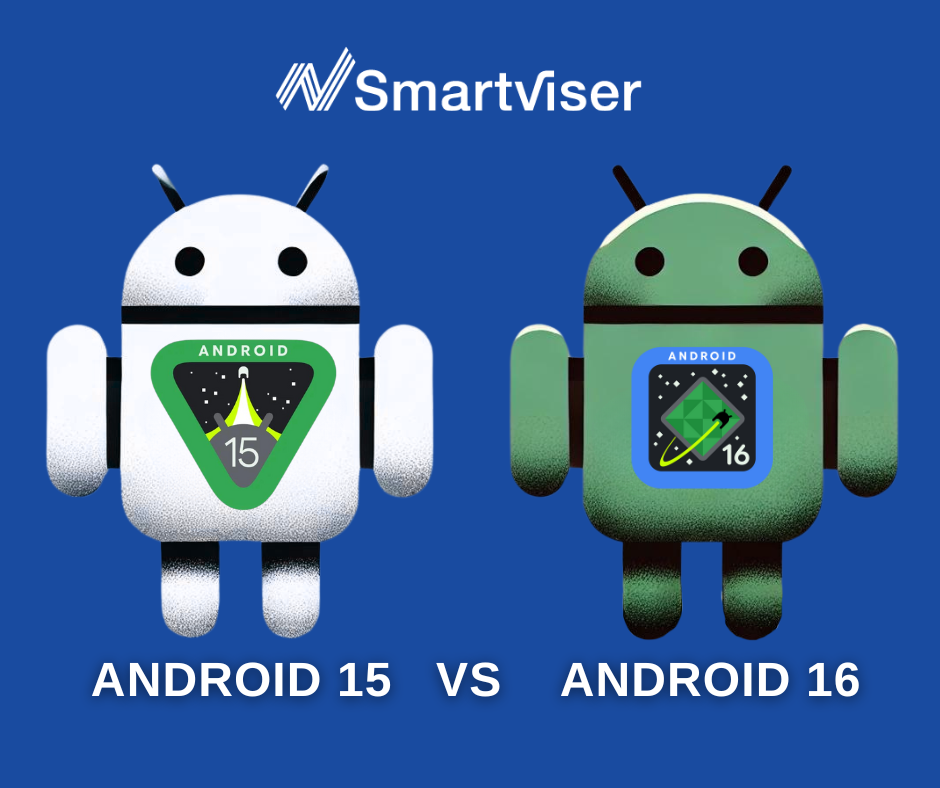
Android 15 vs Android 16: Real-World Benchmarks on the Pixel 8a with SmartViser’s Viser Neo
At SmartViser, we prioritise rigorous testing with our Viser Neo automation platform whenever a new Android release arrives. Each upgrade introduces new features, refinements, and potential optimisations—but the real question is: do they make a measurable difference in end-user experience?
Using our Viser Neo active test automation platform, we benchmarked Android 15 (“Vanilla Ice Cream”) against Android 16 (“Baklava”) on the Google Pixel 8a. Our tests focused on the areas most relevant to users: battery life, gaming, web performance, data throughput, and streaming efficiency.
To ensure fairness, both devices were set up under strictly controlled conditions: automatic brightness was disabled, volume levels were aligned, and all battery power-saving features were switched off. This guarantees that results reflect the OS performance itself, not environmental inconsistencies.
Feature Differences: Android 15 vs Android 16
Android 15 Highlights
Privacy & Security: Theft Detection Lock, Private Space, stronger authentication.
Multitasking: Partial screen sharing, app pair shortcuts for foldables/tablets.
Notifications: Notification Cooldown to limit repetitive alerts.
Media & Developer Tools: HDR image format support, predictive back gesture, improved app archiving.
Android 16 Enhancements
Material 3 Expressive UI: Richer animations, dynamic colors, blur effects.
Notifications: Live Updates, adaptive progress-based alerts.
Desktop Multitasking Mode: Early implementation for tablets and large screens.
Security & Privacy: Advanced Protection, USB port blocking, offline lock, enhanced Health Connect API.
Audio/Media: Auracast audio sharing, APV codec for high-quality video, integrated photo picker with cloud services.
Performance & Dev Tools: Enforced adaptive apps, improved scheduling, and vertical text support.
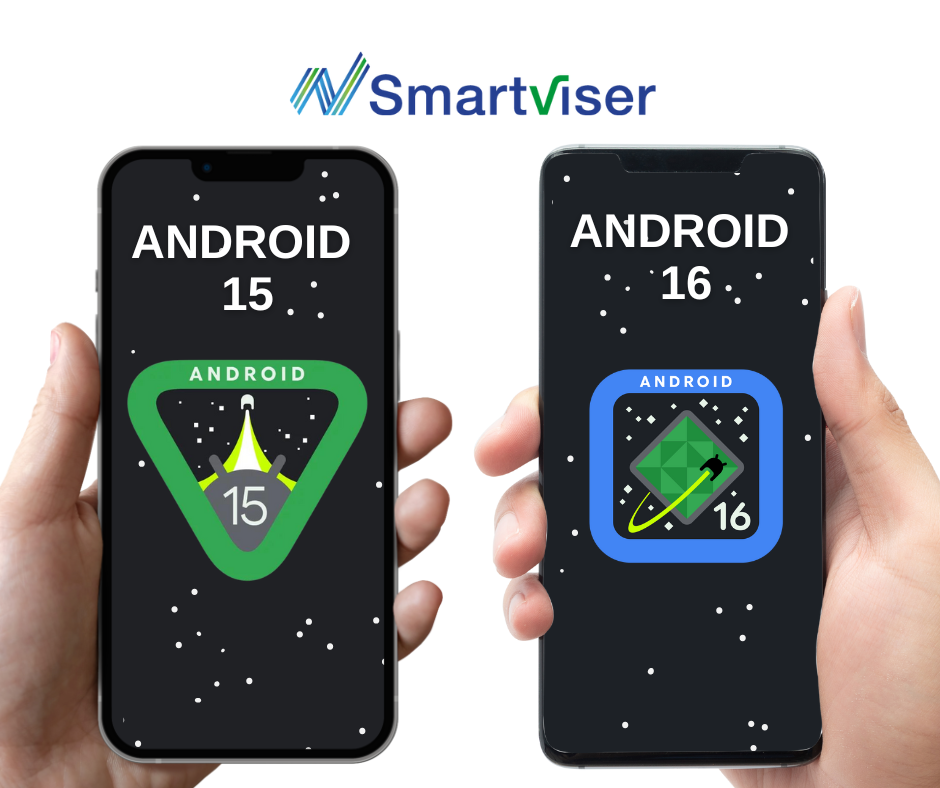
Category | Android 15 | Android 16 |
UI & Design | Material You refinements | Material 3: Expressive animations, color, blur effects |
Notifications | Notification cooldown | Live Updates, progress notifications, bundling, cooldowns |
Multitasking | App pairs, partial screen sharing | Desktop mode (tablet), adaptive apps support |
Media & Pickers | HDR support | Embedded photo picker with cloud integration |
Security & Privacy | Theft detection, private space | Advanced Protection, USB/blocking, battery health tools |
Audio/Video | APV codec, Auracast audio sharing | |
Health Data Integration | FHIR support in Health Connect | |
Performance & Dev Tools | App archiving, ART improvements | Compatibility mode, efficient scheduling |
Test Environment Validation
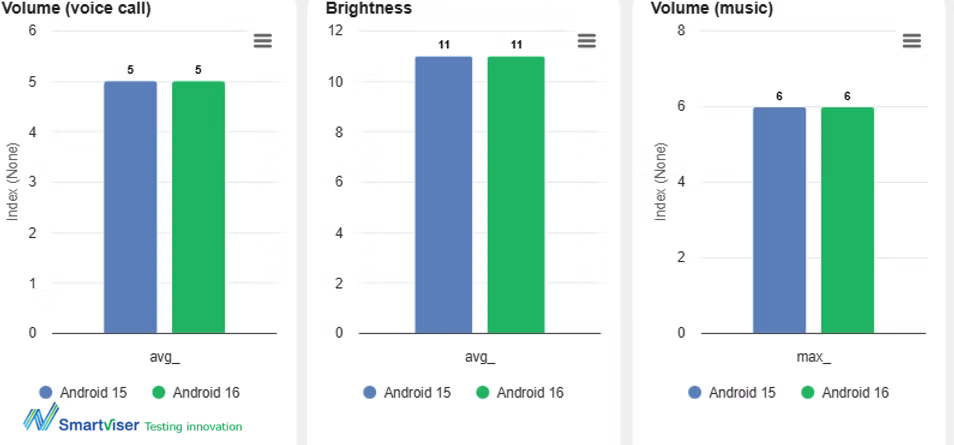
Before diving into performance benchmarks, it’s critical to ensure both Android 15 and Android 16 were tested under identical and controlled conditions. Using Viser Neo, we validated the test environment and recorded the following baseline parameters:
Volume (Voice Call): Both OS versions were set to an average level of 5.
Brightness: Both maintained the same average brightness setting of 11, with automatic brightness disabled.
Volume (Music): Both set to the same maximum level of 6.
These consistent settings confirm that differences observed in later benchmarks—whether in battery performance, gaming, web performance, data throughput, or streaming—can be attributed to the OS changes rather than test setup inconsistencies.
Web Browsing Performance
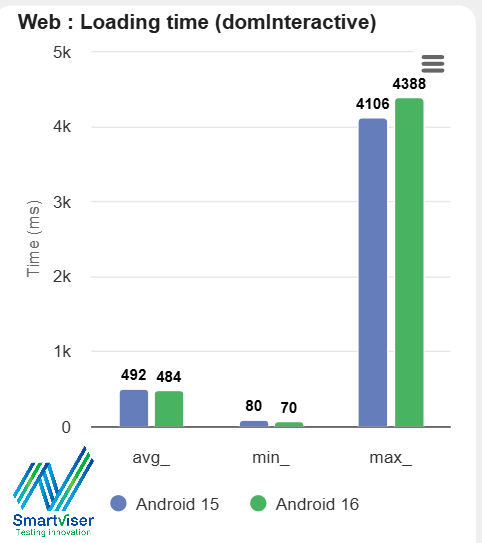
To evaluate real-world browsing speed, we tested multiple websites and measured Interactive loading time using Viser Neo. Results showed:
Average Loading Time: Android 15 – 492 ms, Android 16 – 484 ms
Minimum Loading Time: Android 15 – 80 ms, Android 16 – 70 ms
Maximum Loading Time: Android 15 – 4106 ms, Android 16 – 4388 ms
Overall, both OS versions delivered near-identical browsing performance, with Android 16 showing a slight advantage in average and minimum loading times. The higher maximum value on Android 16 suggests that occasional page load spikes still occur, likely influenced by network or rendering variations rather than core OS changes.
These findings indicate that end users moving from Android 15 to Android 16 are unlikely to notice significant differences in day-to-day browsing speed.
Data Performance
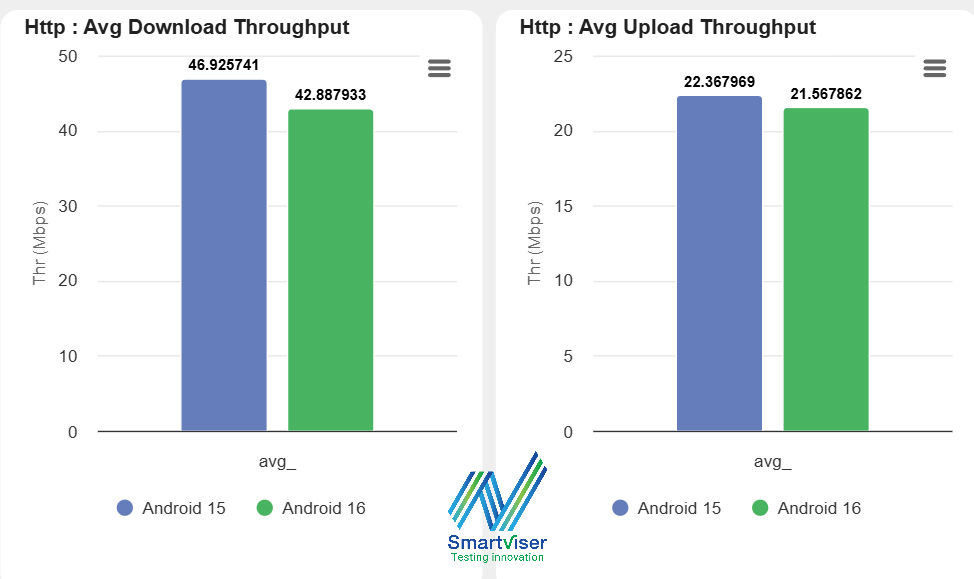
Using Viser Neo, we benchmarked HTTP download and upload throughput to assess raw data performance under controlled conditions. The average results were:
Average Download Throughput: Android 15 – 46.93 Mbps, Android 16 – 42.89 Mbps
Average Upload Throughput: Android 15 – 22.37 Mbps, Android 16 – 21.57 Mbps
In both upload and download, Android 15 slightly outperformed Android 16, though the differences are small enough that most users may not notice in everyday tasks such as web browsing, social media uploads, or streaming. These results could be influenced by subtle differences in network stack behaviour or background OS processes in Android 16.
Battery Performance

To simulate a typical day of user activity, we ran continuous mixed-use scenarios including gaming, browsing, streaming, file transfers, and idle time. Both Android versions were tested under identical conditions with all power-saving features disabled.
Battery Life:
Android 15 – 17h 13m 08s
Android 16 – 17h 13m 11s
The results show no meaningful difference in endurance, with both versions performing almost identically.
Current Consumption (per activity):

Gaming (WebGL) remained the most demanding activity, averaging around -1350 mA on both OS versions.
Other tasks such as web browsing, video streaming, HTTP upload/download, and local playback showed similar consumption across Android 15 and 16, confirming stable energy profiles.
Battery Temperature:

Average temperature on Android 15: 25.9°C
Average temperature on Android 16: 26.2°C
Both showed consistent thermal management patterns, with Android 16 running fractionally warmer but without significant deviation.
Takeaway: Battery endurance, consumption distribution, and thermal stability remain consistent between Android 15 and 16. Users upgrading should not expect gains or losses in daily longevity, which highlights the maturity of Google’s power optimization across Android releases.
Gaming Performance
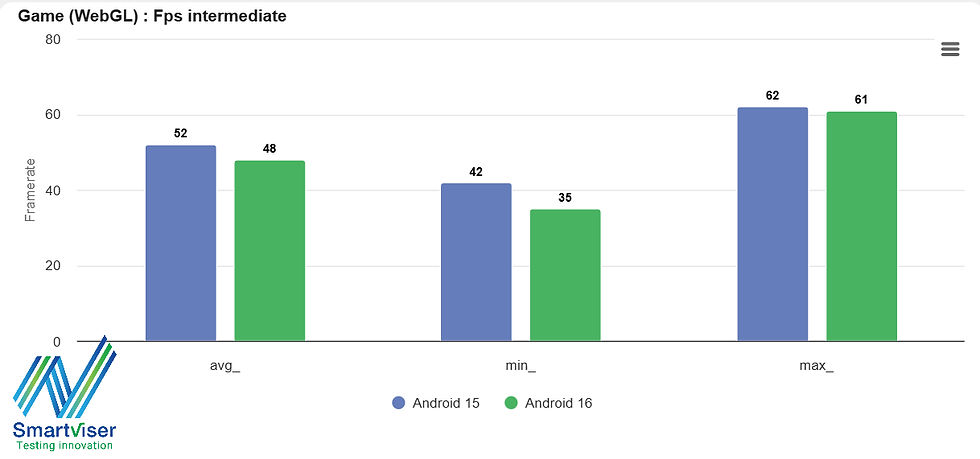
Gaming remains one of the most demanding use cases, so we tested WebGL-based graphics performance to measure frames per second (FPS).
Average FPS: Android 15 – 52 FPS, Android 16 – 48 FPS
Minimum FPS: Android 15 – 42 FPS, Android 16 – 35 FPS
Maximum FPS: Android 15 – 62 FPS, Android 16 – 61 FPS
While both OS versions delivered a smooth experience, Android 15 consistently achieved slightly higher frame rates across all measurements. On Android 16, frame rates dipped more significantly at the lower end (minimum FPS), which could result in occasional drops in fluidity during demanding gaming sessions.
This suggests that while Android 16 introduces new system-level features and UI improvements, its graphics pipeline may still require further optimisation for high-performance gaming. For most casual users, the difference will be marginal, but heavy gamers may notice Android 15 running a touch smoother under intensive loads.
Streaming Performance
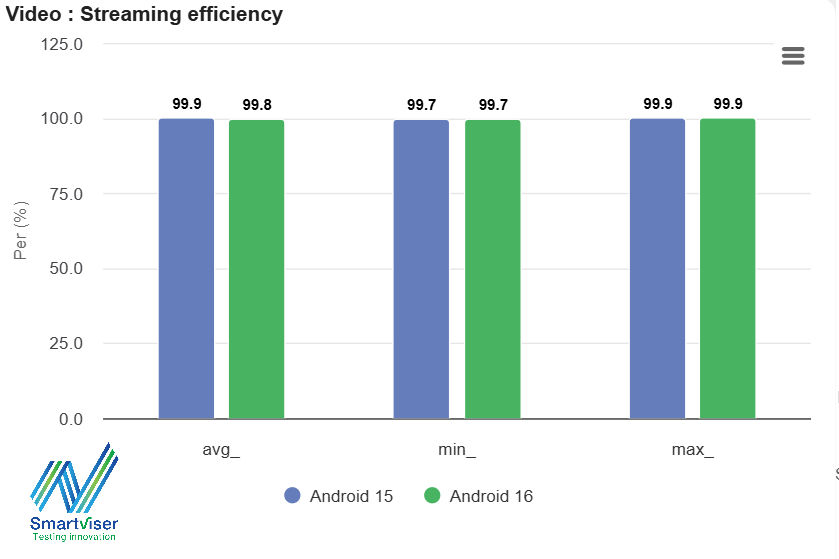
For video streaming, we measured streaming efficiency, representing how consistently data was delivered and rendered without stalling or buffering.
Average Efficiency: Android 15 – 99.9%, Android 16 – 99.8%
Minimum Efficiency: Both Android 15 and 16 – 99.7%
Maximum Efficiency: Both Android 15 and 16 – 99.9%
These near-perfect results show that both OS versions handle video streaming seamlessly, with no meaningful difference between Android 15 and Android 16. End users should expect smooth playback, stable buffering, and no visible degradation when upgrading.
Conclusion & Recommendation
Our benchmarking of Android 15 vs Android 16 on the Google Pixel 8a, using SmartViser’s Viser Neo test automation, shows that the two operating systems deliver a very similar end-user experience under controlled lab conditions.
Battery Life & Thermal Stability: Both OS versions lasted over 17 hours, with almost identical current consumption across usage scenarios. Temperature remained stable, with Android 16 only marginally warmer on average.
Web Browsing: Both OS versions were highly comparable, with Android 16 showing a slight edge in average and minimum loading times, though occasional load spikes still occur.
Data Performance: Android 15 recorded slightly higher upload and download throughput, but the difference is small and unlikely to impact real-world user experience.
Gaming: Android 15 achieved higher average and minimum FPS, making it the better performer for intensive gaming. Android 16 is smooth for casual play but may require further optimisation for demanding titles.
Streaming Efficiency: Both versions delivered near-perfect performance (≈100%), ensuring smooth and reliable video playback.
SmartViser’s Take
For end users, upgrading to Android 16 will not drastically change performance in key areas like battery life, browsing, streaming, or daily app usage. The main improvements of Android 16 lie in new features, UI refinements, and enhanced security tools rather than raw performance gains.
If you are a heavy gamer, Android 15 may still feel marginally smoother, but most other users will not notice a difference.
If you value security, privacy, and new functionality, Android 16 is the clear choice, offering features like Advanced Protection, improved multitasking, and Material 3 UI updates.
Ultimately, the upgrade decision comes down to whether users prioritise stability and slightly better gaming on Android 15, or new features and improved system-level protections on Android 16.
At SmartViser, our role is to ensure these insights are backed by real measurements under repeatable conditions, helping the industry and end-users alike make informed choices.
About SmartViser’s Viser Neo
All benchmarks in this study were conducted using SmartViser’s Viser Neo test automation solution. Viser Neo enables fully automated, repeatable, and reliable performance testing across any device—regardless of operating system, chipset, model, or brand. This flexibility allows us to deliver unbiased insights and validate real-world end-user experience across a wide range of scenarios.
With Viser Neo, manufacturers, operators, and enterprises can accelerate device benchmarking, compare OS upgrades, and ensure that every change delivers measurable value to end users.

Susie Siouti is the Chief Commercial Officer for SmartViser helping organisations in the Telecommunications industry offer superior end-user quality of experience and service with the introduction of innovative test automation products. Susie has 20 years of experience in the Telecoms industry and in that time has led teams across the world mainly in Testing and Compliance. Holding an MBA from Henley Business School brings a diverse set of skills and expertise, including business acumen, strategic thinking, financial management, sales and marketing expertise, leadership, and innovation.
Susie joined SmartViser in 2016, is part of the internal steering committee, responsible for developing and implementing the company's commercial strategy and encouraging a customer-centric culture. The main mission is to help organizations to create value by offering better quality products and services by improving operational efficiency and innovation.

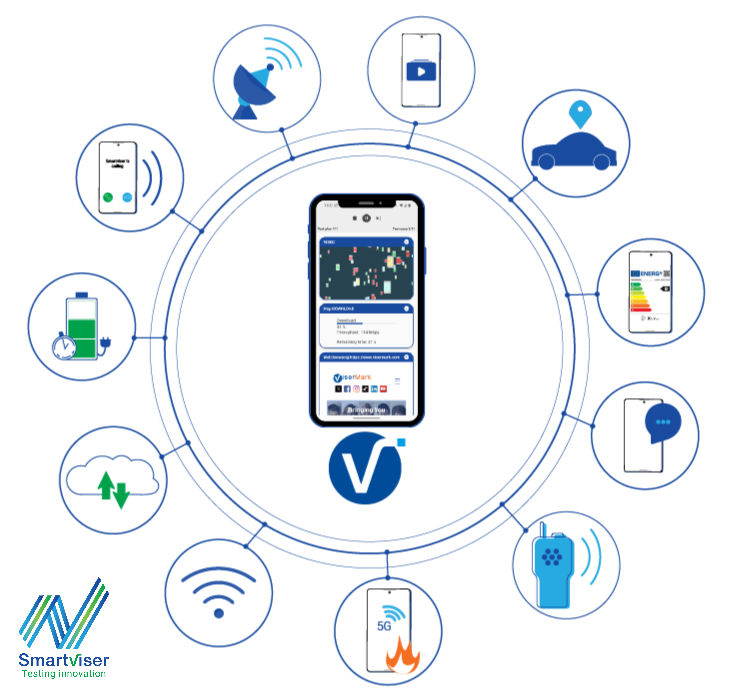




Comments